Louisville, Kentucky – Saturday, May 9th, 2009
There was a time in the mid 90’s when Kentucky Kingdom was on the cutting edge of the amusement industry and there appeared to be no bounds as to what they could do in the future. Unlike other regional small parks at the time such as Holiday World or Indiana Beach, which were focused on limiting their appeal to local families, here was a small park that had huge ambitions to directly take on competition from corporate giants such as Paramount’s Kings Island or Six Flags’ Great America and Mid-America. Nearly every year after 1990, when they debuted the Vampire and Thunder Run, saw the installment of yet another big-impact and/or prototype ride, including both the world’s first Intamin 2nd-gen freefall and North America’s first suspended looping coaster in ’95; both the experimental Top Eliminator Dragsters and Thrill Park Theater in ’96; the year after, Chang, B&M’s largest ride to date and their first contracted with a non-corporately owned park; and then in 1998 the world debut of a double-tracked dueling coaster. That last year,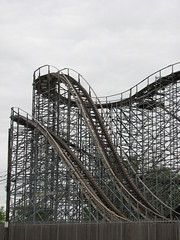 1998, also saw the park bought out by Premier Parks, a chain eponymous for spending gross sums of money on multiple headlining attractions annually with seemingly no concern for budget, so naturally development nearly came to a halt at Kentucky Kingdom after the addition of a partially re-located raft ride in 1999 and a production model Wild Mouse the year after. The relocation of a used coaster in 2003, Greezed Lightnin’, was hardly in the vein of what had came the decade before, and in the time since only the waterpark (uniquely situated as a centerpiece hub in the dry park) has seen any capital expansion, most notably the electro-magnetic uphill waterslide Deluge in 2007, a ride I feel the old Kentucky Kingdom may have been proud of but I fear it was too little too late. And now the park is loosing rides with no concessional replacements in sight. Top Eliminator Dragsters in 2005, Superman: Tower of Power (which I think the accident that spurred it’s removal was just bad karma left from renaming it that year from the most awesome name ever for a drop tower, the Hellevator), and now the entire Mile High Falls and Twisted Twins area of the park has been shut down and also appears to be in danger of closing.
1998, also saw the park bought out by Premier Parks, a chain eponymous for spending gross sums of money on multiple headlining attractions annually with seemingly no concern for budget, so naturally development nearly came to a halt at Kentucky Kingdom after the addition of a partially re-located raft ride in 1999 and a production model Wild Mouse the year after. The relocation of a used coaster in 2003, Greezed Lightnin’, was hardly in the vein of what had came the decade before, and in the time since only the waterpark (uniquely situated as a centerpiece hub in the dry park) has seen any capital expansion, most notably the electro-magnetic uphill waterslide Deluge in 2007, a ride I feel the old Kentucky Kingdom may have been proud of but I fear it was too little too late. And now the park is loosing rides with no concessional replacements in sight. Top Eliminator Dragsters in 2005, Superman: Tower of Power (which I think the accident that spurred it’s removal was just bad karma left from renaming it that year from the most awesome name ever for a drop tower, the Hellevator), and now the entire Mile High Falls and Twisted Twins area of the park has been shut down and also appears to be in danger of closing.
What happened? Was it simply too much too fast, and now that bubble built up in the 1990’s has popped (talk about mirroring real-world events), or have the corporate changeovers been the contributing factor? Walking around the park, I was pleased to see that some of the edgy, progressive feel the park had going in the 90’s was still present in some areas (such as around Chang/Deluge/T2, and in a more refined state in the Belgian Village section of the park), but honestly, time has not been kind to Kentucky Kingdom. While they always were the first to invest in prototype attractions, other parks followed suit in the years to come, now leaving KK with the most outdated rides of their class that ultimately are second to all. Twisted Twins was perhaps the only exception, Gwazi and Lightning Racers being the only other dueling wooden coasters to follow in its footsteps, and both of those were more graceful, twister-styled rides from GCI compared to Twin’s dangerously sharp and steep plunges and hard laterals courtesy of CCI. With Twins and Hellevator now out of the picture, that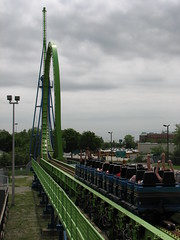 leaves only three major thrill rides for the park, all generally disliked by today’s standards: A B&M Stand-up (rough), a Curtis D. Summers woody (rough), and the prototype U.S. installation of a Vekoma SLC (death). Compared to other parks in the Six Flags chain this one seems to have drawn the short stick.
leaves only three major thrill rides for the park, all generally disliked by today’s standards: A B&M Stand-up (rough), a Curtis D. Summers woody (rough), and the prototype U.S. installation of a Vekoma SLC (death). Compared to other parks in the Six Flags chain this one seems to have drawn the short stick.
That isn’t counting Greezed Lightnin’, a Schwarzkopf shuttle loop, which are generally well-regarded rides despite the simplicity (or perhaps because of the simplicity, it’s hard to say). This was a natural first ride to try out while in the park, especially since the mouse next door has intolerably long lines stemming from three-car operations. Lines weren’t too bad in the morning, and were nearly nonexistent later that afternoon; I worried that being a one-train shuttle operation it is disadvantaged compared to its multi-trained, complete circuit brethren, but the ride cycle is short enough, the train capacity high enough, and restraint-checking quick enough that it actually manages to be the highest throughput coaster in the park, not that the single-train Thunder Run, 7-seater T2, or Chang (with a Chinese finger trap restraint system) were competition.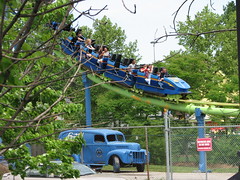
The key to this ride is that is uses only a non-invasive lapbar. From the launch to the vertical loop and then the free-falling forward spike, all of these moments need to be experienced with complete upper-body freedom. The centerpiece loop provides that perfect, heels over head sensation that seems missing from a lot of more complex inverting maneuvers; it’s just there to have fun, and of course the real joy of the ride is after enjoying the delicious centripetal roundabout once, I got to savor it a second time mere seconds later, but in reverse, and with a scant hint of more hang-time from the slight loss of speed. Unfortunately the brakes on the way back kick in harder than I imagine they used to when the ride operated in the 70’s and 80’s at Great America, making the rear tower more of an afterthought. That rear spike does have an interesting curvature to it, seeming to get very tight before sharply transitioning to the straight ramp.
time mere seconds later, but in reverse, and with a scant hint of more hang-time from the slight loss of speed. Unfortunately the brakes on the way back kick in harder than I imagine they used to when the ride operated in the 70’s and 80’s at Great America, making the rear tower more of an afterthought. That rear spike does have an interesting curvature to it, seeming to get very tight before sharply transitioning to the straight ramp.
One other thing I just realized was that this was the first time I had ever been to a Six Flags park where I was able to get re-rides on a coaster within ten minutes of each other, excluding a visit to Six Flags Great Adventure in 2003 where we headed to Medusa first thing in the morning and got four consecutive rides without getting off. Every other ride I’ve been to at Six Flags I’ve always been greeted with a minimum half-hour wait time from busy crowds, so this was a pleasant change to encounter for once.
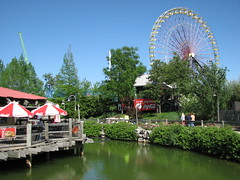 I don’t understand claims that the park itself is unpleasant. I can’t vouch for everyone’s customer service experiences, but I found Kentucky Kingdom to be a surprisingly quaint, humble and well thought out park. Both the original side of the park and the back side leading through to the Belgian Village section were finely designed, somewhat low-key areas featuring plenty of shade and landscaping with well-integrated attractions. T
I don’t understand claims that the park itself is unpleasant. I can’t vouch for everyone’s customer service experiences, but I found Kentucky Kingdom to be a surprisingly quaint, humble and well thought out park. Both the original side of the park and the back side leading through to the Belgian Village section were finely designed, somewhat low-key areas featuring plenty of shade and landscaping with well-integrated attractions. T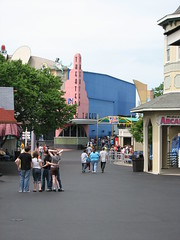 he area that Twisted Twins and Mile High Falls occupied was a bit of a problem spot as I recall, being an oddly shoehorned cul-de-sac that was incapable of drawing a crowd, so I do hope Six Flags’ choice to close that area off indicates they’re looking to redesign that part of the park in the future rather than are simply trying to skim off maintenance and operations costs. The only other place I’d say that felt a bit more ‘typical Six Flags’ was the southern end of the park (between Chang and the Giant Wheel) which is a little concrete heavy. After crossing the bridge that separates the two halves of the park we found ourselves in line for the Giant Wheel to grab some pictures before heading on to the rest of the park. This is an incredible park centerpiece that seems tragically neglected, with a temporary-looking queue set-up, fading paint and they only loaded two sets of six cars on either side of the wheel when they have forty gondolas available.
he area that Twisted Twins and Mile High Falls occupied was a bit of a problem spot as I recall, being an oddly shoehorned cul-de-sac that was incapable of drawing a crowd, so I do hope Six Flags’ choice to close that area off indicates they’re looking to redesign that part of the park in the future rather than are simply trying to skim off maintenance and operations costs. The only other place I’d say that felt a bit more ‘typical Six Flags’ was the southern end of the park (between Chang and the Giant Wheel) which is a little concrete heavy. After crossing the bridge that separates the two halves of the park we found ourselves in line for the Giant Wheel to grab some pictures before heading on to the rest of the park. This is an incredible park centerpiece that seems tragically neglected, with a temporary-looking queue set-up, fading paint and they only loaded two sets of six cars on either side of the wheel when they have forty gondolas available.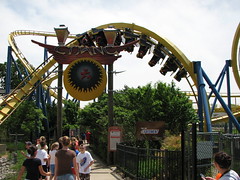
Next is the park’s signature attraction, Chang. The ride is mostly a mirror image of Cedar Point’s Mantis, the only differences are it is supposedly slightly larger and faster, and with a different ending after the corkscrew off the midcourse brake, Mantis featuring a tightly plotted figure-eight maneuver, while Chang’s features a second corkscrew and a few more spread-out twists and turns. Chang also has only seven cars per train while Mantis has eight, presumably because they didn’t expect as large of crowds as Cedar Point. The entrance to Chang is a work of art however, a tangled network of track flying in all directions, coalescing into the centerpiece entryway tucked beneath the second corkscrew.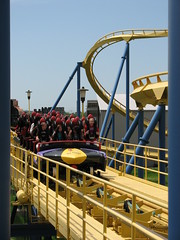
I really like B&M stand-up coasters, in fact I would probably rate most of their stand-up designs as among their best. They feature a much more eclectic variety of twists and turns in a layout that isn’t dominated by a never-ending succession of off-the-shelf loops or hills. The stand-up ‘gimmick’ isn’t even that distracting; sure it contributes to lengthier loading procedures and you run the risk of walking funny for the rest of the day if you don’t stand up properly, but it also makes you feel much more vulnerable and amplifies many of the g-forces. That light pop of air on the s-curve before the midcourse brake, while maybe a little fun on most seating arrangements, can be quite scary in these stand-up vehicles. The real downside to the stand-up design is the tall, cumbersome trains easily become unbalanced and start to produce a horrible rattling that’s absorbed by your ears from the shoulder harness if not properly maintained. Mantis used to always be like that but the past two seasons I’ve managed to get some truly great rides no rougher than an average Raptor excursion, so needless to say I was hoping for the same this year from Chang.
The ride starts with a tight left swoop turn off the lift, stalling for just a moment before diving down the first drop. I think I like this approach much better than the direct twisting first drop found on most other B&M coasters, including the third mega-standup built, Riddler’s Revenge, although Mantis I think makes better use of this maneuver, towering over the water and nearby rides (there’s always a strong lakeside breeze present that I only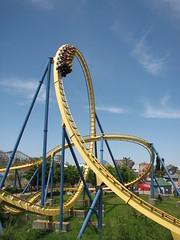 ever notice at the top of Mantis’ lift) while Chang merely towers over a field and go-kart track. I think Chang’s first drop profile might be slightly different, not as steep and featuring a much longer pull-over, but I’m not certain. The first two loops are ‘wow’ moments with their indomitable scale and hang-time at the top; remember this is with stand-up restraints, so if you’re of average size you’ll have enough space to fall a few inches until your shoulders hit the top of harness. Things begin to tighten and gain more uniqueness to them with the next two maneuvers: the inclined pretzel-helix that takes place over the station, a perfect moment to show off the ride’s grace and remove my worries that I might encounter headbanging through the twists and turns, followed by the inclined loop, one of only three in the world and I wish they’d build more as they produce some odd dynamics while retaining that heel-over-head sensation not frequently found on the
ever notice at the top of Mantis’ lift) while Chang merely towers over a field and go-kart track. I think Chang’s first drop profile might be slightly different, not as steep and featuring a much longer pull-over, but I’m not certain. The first two loops are ‘wow’ moments with their indomitable scale and hang-time at the top; remember this is with stand-up restraints, so if you’re of average size you’ll have enough space to fall a few inches until your shoulders hit the top of harness. Things begin to tighten and gain more uniqueness to them with the next two maneuvers: the inclined pretzel-helix that takes place over the station, a perfect moment to show off the ride’s grace and remove my worries that I might encounter headbanging through the twists and turns, followed by the inclined loop, one of only three in the world and I wish they’d build more as they produce some odd dynamics while retaining that heel-over-head sensation not frequently found on the 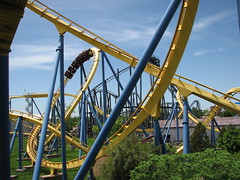 more experimental of inversions.
more experimental of inversions.
Instead of holding the “up-into-an-element, down-into-a-high-speed-pullout” rigmarole throughout the entire first half as most B&M coasters are prone to do, Chang then hits us with that high-speed s-curve featuring a pop of air at ground level I mentioned earlier, before swooping up into the obligatory midcourse block brake. I know Mantis’ third train has been in storage for over a decade, but did Chang ever even have a third train to begin with? From here there’s a straight dive down off the brake run (hey, with more air in the back, and who said that stand-ups are nothing but positive g’s?) directly into the first corkscrew.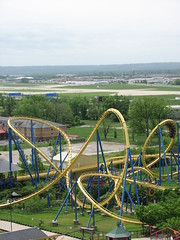
Until now things have pretty much been identical to Mantis, so it was this final part of the ride that was of most interest to me. It starts things with a quick S-curve to the right and then the left, threading through the dive loop and continuing left as it swoops towards ground level and then whips around the second corkscrew, which is much the same as the first except it’s a bit snappier and lower to the ground. It sweeps up again into another high curve before meandering back towards the 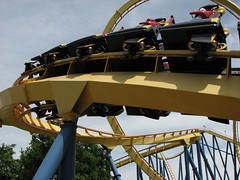 ground and making one final left-hand curve into the brake run.
ground and making one final left-hand curve into the brake run.
Mantis is the better coaster. While it lacks the fifth inversion, the rest of the curves that comprise Chang’s second half are just too loose and directionless. It’s basically one corkscrew leading into a drawn-out s-curve/helix, then another corkscrew, followed by a second drawn-out s-curve. Mantis is so tight, switching directions on a dime multiple times within seconds of each other, and with much steeper banking and tighter radii; the second corkscrew is hardly missed.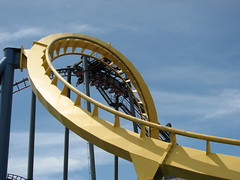 In fact, I would say that on Chang’s layout the second half becomes only about the two corkscrews with the other turns used as filler between these moments, while Mantis stays in the moment all the way to the brake run. Overall though, I was very pleased with Chang, in fact I might even go so far to say it was my favorite B&M on the trip (the only competition was… Diamondback). Much more aggressive and with a lot more composing the layout than can be found on most B&M coasters. Besides their stand-up coasters, Dominator I think is the only other glimpse at a B&M looping coaster where the focus isn’t just on an endless series of loops or similar maneuvers until the ride ends, so I’ve always appreciated these stand-ups for that, even if they are unreliably rough at times.
In fact, I would say that on Chang’s layout the second half becomes only about the two corkscrews with the other turns used as filler between these moments, while Mantis stays in the moment all the way to the brake run. Overall though, I was very pleased with Chang, in fact I might even go so far to say it was my favorite B&M on the trip (the only competition was… Diamondback). Much more aggressive and with a lot more composing the layout than can be found on most B&M coasters. Besides their stand-up coasters, Dominator I think is the only other glimpse at a B&M looping coaster where the focus isn’t just on an endless series of loops or similar maneuvers until the ride ends, so I’ve always appreciated these stand-ups for that, even if they are unreliably rough at times.
Making our way around the back circle the next major attraction on our to-do list was… um… (searches desperately for kiddie coasters in the area to delay the inevitable; there are none)… T². The line wasn’t that bad to justify skipping this one either, and both trains were running. We ended up in the shortest line which was the back row. The station is built up in a very 90’s industrial style, and on engaging the lift the nearby bushes and trees come close enough to kick with your feet. It’s on the lift that I mention to my dad, who I think is expecting a ride similar in smoothness to Michigan’s Adventure’s Thunderhawk (that one’s a really smooth, enjoyable SLC) that he may want to brace himself; this is the a prototype SLC, before they refined it into its usual headbanging glory.
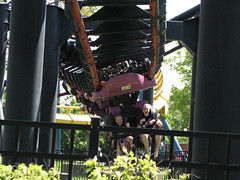 Actually my distaste for SLCs isn’t nearly as strong as most enthusiasts. As I mentioned, Thunderhawk is a truly enjoyable ride, and it shows that the layout is actually a decent one as well, with the unique double-rollover loop to start the ride, strong pacing throughout the middle, and intense, disorienting double barrel roll finale that could put many B&M inverts to shame. The other models I’ve been on have not been so kind to my skull, but I just now realized that besides Geauga Lake, Michigan’s Adventure and Kentucky Kingdom, the only other SLC I’ve ever been on was Elitch Garden’s Mind Eraser that was quite bad, although that was back in 2002. I passed on riding
Actually my distaste for SLCs isn’t nearly as strong as most enthusiasts. As I mentioned, Thunderhawk is a truly enjoyable ride, and it shows that the layout is actually a decent one as well, with the unique double-rollover loop to start the ride, strong pacing throughout the middle, and intense, disorienting double barrel roll finale that could put many B&M inverts to shame. The other models I’ve been on have not been so kind to my skull, but I just now realized that besides Geauga Lake, Michigan’s Adventure and Kentucky Kingdom, the only other SLC I’ve ever been on was Elitch Garden’s Mind Eraser that was quite bad, although that was back in 2002. I passed on riding 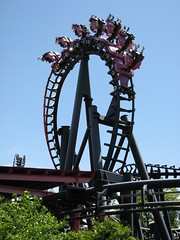 Canada’s Wonderland’s and Six Flags America’s when given the chance.
Canada’s Wonderland’s and Six Flags America’s when given the chance.
We crawl off the lift and down the twisting plunge, and to my surprise the ride actually isn’t all that rough. Sure, we’re jostled around a little bit, but my head never takes impact with the restraint and I’m able to enjoy each element the ride throws at me. There are some differences between this ride and the rest of the SLCs, most obvious are the shorter, seven car trains (most SLCs have ten) and the straight dip before the brake run, where on later versions it includes an s-curve. Not as obvious are some strange banking techniques that were corrected in later versions. Slight cases of underbanking or some wierd transitioning, and most humorous is the 90 degree bank on the exit of the barrel rolls that holds us on our side for a few seconds without doing anything. Again, nothing painful, just weird.
We contemplated giving Deluge a try, which was open even though the rest of the water park was closed, but we ended up skipping around to do Thunder Run before committing to a soaking on Deluge (we figured we could dry off more effectively with a second Chang run). The line for Thunder Run was not ideal. While it wasn’t too long in any absolute sense, the ride only runs one train (pretty sure that’s all it has, too) which meant close to an hour spent in line. When we got to the station I found that for some reason there was no extra wait for the front row so we opted for that, to make the most of our long wait. Although I was not a fan of either Hurler at Carowinds or Kings Dominion, the similarly patterned Thunder Run I found much more effective, perhaps because it was running much smoother and faster than the other two, and because there’s quite a few trees and landscaping lining the low to the ground sections of track that compose most of the ride, giving at least some sense of perspective.
The layout is something of an inverse of the standard classic wooden design, where the turnarounds are utilized as gentle lulls between the core of the airtime hills. Here, it’s on the turns where things are at their fastest, most rip-roarin’, and it’s the air hills that actually serve as more of the breather with their bountiful, floaty airtime. They’re actually not much of a breather, so the ride is pretty much just a first drop into non-stop, relentless speed for the entire course. Unfortunately things get weaker as it goes on, with the second leg of the trip only featuring a small hop before making another turnaround, and it ends on a low note with the slowest-paced turn of the ride feeding us into the brakes.
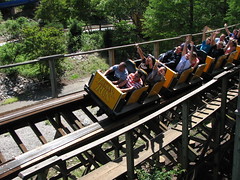 One thing that’s interesting about Thunder Run is the banking technique that leads into and out of the turns. When viewed from overhead it clearly has a parabolic shaping to it that decreases in radius as the banking increases, mathematically providing perfectly sustained laterals in the transitions. What makes this special is that not even Great Coasters or the Gravity Group really design their turns like this, from overhead their footers are arranged mostly in circles and lines with few exceptions. They don’t really need to, because what designer Curtis D. Summers apparently didn’t realize is that you don’t really need that long of a span of track to make a transition. It can be done in the space of just a few bents, and Gravity Group and GCI both employ some heartlining techniques that even things out, so when surveying the land they only
One thing that’s interesting about Thunder Run is the banking technique that leads into and out of the turns. When viewed from overhead it clearly has a parabolic shaping to it that decreases in radius as the banking increases, mathematically providing perfectly sustained laterals in the transitions. What makes this special is that not even Great Coasters or the Gravity Group really design their turns like this, from overhead their footers are arranged mostly in circles and lines with few exceptions. They don’t really need to, because what designer Curtis D. Summers apparently didn’t realize is that you don’t really need that long of a span of track to make a transition. It can be done in the space of just a few bents, and Gravity Group and GCI both employ some heartlining techniques that even things out, so when surveying the land they only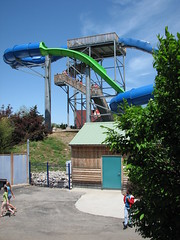 need to work with circles and lines. Just a minor thing to note, but I also think it helps debunk this myth going around that GCI and Gravity Group are so much more advanced and knowledgeable than the archaic methods used back in the 70’s, 80’s and early 90’s.
need to work with circles and lines. Just a minor thing to note, but I also think it helps debunk this myth going around that GCI and Gravity Group are so much more advanced and knowledgeable than the archaic methods used back in the 70’s, 80’s and early 90’s.
On exiting the ride I noticed a raft on Deluge was stuck near the top of one of the electromagnetic hills (I didn’t know they could do that!) and a maintenance worker had to climb up to unjam the car from the magnetic pull an send it back down the way it came up. This meant that not only was the ride still not open when we got there, but the line had increased to at least double what it had been earlier. Not really wanting to get soaked and with no place to put the camera besides a $2.00 locker (I mainly wanted to ride so that I could have a new attraction to vote “favorite waterpark ride” for in the Golden Ticket Awards), we decided to pass up Deluge, as well as a Chang re-ride. I guess the long wait for Thunder Run just took too much out of us and it seemed rather pointless to spend more hours waiting in lines for the same rides we had already done. And we were hungry.
Looking over the coupon booklet I got with my season pass I noticed that one of the few food discounts was a $2 funnel cake, if you bought one at regular price. Um, we can make this work, can’t we? We each get our own funnel cake at a shop next to Greezed Lightnin’, and upon hearing that all toppings are free, I order everything on the menu for my cake. I think that was chocolate syrup, caramel, powdered sugar, cherries and apples, all congealed into one incredibly high fructose confection. I think I got my monies worth. Needless to say, we had no desire to do any more riding after that, so we decided to head back to our hotel room to get some rest before making any evening plans. Speaking of our hotel, before closing out this report I just want to say this: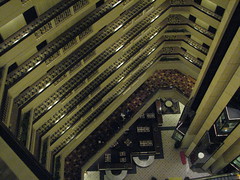
Hotwire.com is a site I can recommend for finding some good hotel deals. How does this look when I’m searching for places to stay the weekend in Louisville: four-star hotel located in the heart of downtown, for only $69 a night? Well normally I don’t go above $50 a night if I can help it, but since this is a fairly compact trip and the park closes at 7:00 leaving us the rest of the evening open, that seemed like a fantastic deal. It was on our approach to Louisville that night the reality set in: we’re incredibly unkempt and wearing sweaty coaster t-shirts while on a very tight budget, and we’re about to walk into a four-star hotel with valet service in the middle of a metropolitan area. This is going to be weird.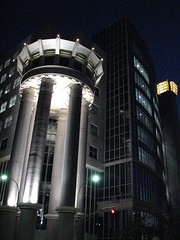
Thankfully it wasn’t too bad, but given our crash budget we did have a minor crisis that first night when we realized that it was going to be very difficult not to incur tips or service fees intended for patrons who had already spent the $150+ that a room would typically cost per night, including parking that was an upwards of $20 per day, unless we didn’t feel like moving our car. Why is it so hard to find hotels out there that are marketed for a more bohemian crowd? One design feature that intrigued me was the entire twenty-or-so stories belonging to the hotel were built around a gigantic open-air center, so that you could theoretically see the door to every single room in the hotel at once. Actually it was a bit unnerving walking around since it was a straight fall down a couple hundred feet to the lobby and the balconies seemed like they’d be oh-so-easy to trip and stumble over.
We spent the night wandering around the city, eventually grabbing a dinner at the Olde Spaghetti Factory (was still full from the funnel cake, however), where the photos can be found here. Tomorrow is Holiday World.
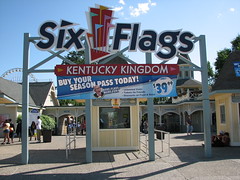
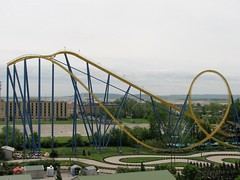
And now Chang is going… going… gone as well. Geesh, glad I got to visit this year. Sounds like a major water park expansion is on it’s way, although I have to wonder just how much they think they can get away with on the dry-park side before people start going elsewhere.
Should have seen this one coming…
http://www.sixflags.com/national/footernav/kentuckykingdom.aspx
what really sucks is six flags still owes money to the kentucky state fair board (who owns the land) and they are refusing to pay it even though they agreed to do it in their contracts. also, i think the whole water park renovation was a scam so they could remove chang without raising suspicions…
also… i actually like how rough T2 is… and my family has loved to joke about how Thunder Run feels like it has square wheels… and i also really like the Lola (blue) track from Twisted Sisters/Twins/Twisted Twins because of some of the unique (though dangerous feeling) moments.
I somewhat believe that MAAAYBE, the complaining of some GP or enthusiasts over a rougher ride with stand-up coasters may have prompted for more drawn out transitions on much larger stand-up coasters, since for some, and especially as of now, they are interpreted to be jarring for some. Then again, I digress with Georgia Scorcher’s existence and how it has some of these somewhat snappier transitions compared to the others. *Again, this should be taken with a grain of salt, as I have no Stand-up coaster credits under my belt.*